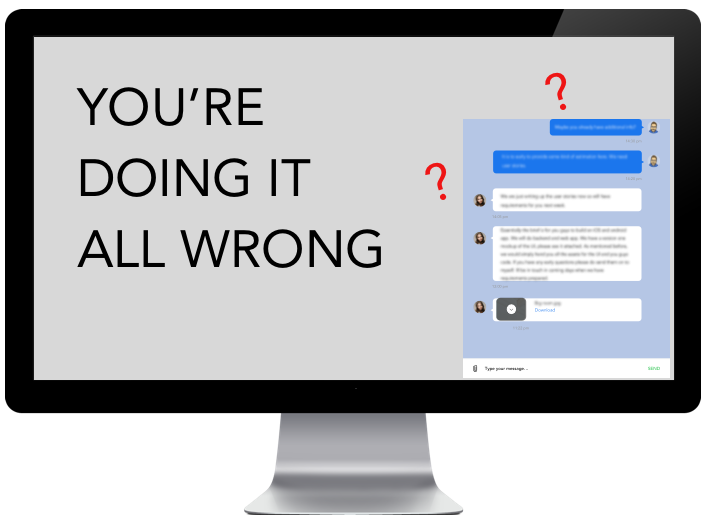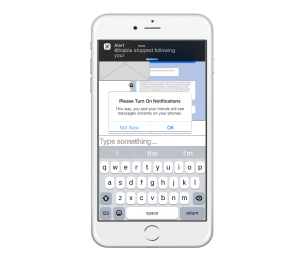Psst… hey there, you. Yes, you. Do you have a question? It’s the little box on the bottom right of the browser window trying to get your attention. Do you want to live chat with us? We’ll answer your question, make you an offer, send you a quote. We’re here for you!

Does this look appealing to you?
Live Chat is great considering the alternatives of email, phone calls, and blasted contact forms. Customers prefer it and so do businesses. But live chat has limitations, limitations we no longer have to live with in a world of text and instant messaging.
What do we mean by live chat limitations?
- The customer has to stay in the same browser tab to keep the live chat going. If they navigate elsewhere, or leave their computer, the agent may have to sit there and wait for them to come back. With so many other distractions like email and facebook, they may or may not.
- There is often no one there to respond. Live chat windows that ask customers to come back later (‘during business hours’) are disappointing. If the customer has a problem with an order, they probably will come back but if it’s a prospective customer interested in a product or service, they probably won’t remember to come back. They’ll go to a competitor instead.
- It’s hard for customers to take a live chat with them. If they have to go to work or tend to something at home, the conversation is over.
- It’s impersonal. Customers typically don’t feel like they’re talking to a live person even if they are. The answers seem robotic and templated and the agent they imagine they’re speaking with is many countries away.
- For customers, it’s hard to keep documentation of live chat. Indeed many live chat interfaces today offer an email copy but that copy doesn’t help the customer much if they want to continue their engagement with the brand. It’s only a backup to pull out if something goes wrong. It does not create further engagement or foster loyalty.
- Live chat is ill suited for mobile. The screen is much smaller, customers get distracted from their browser much faster, and network access is required. If you have live chat on your website, it probably looks like this:

Doesn’t look appealing, does it?
With more than 50% of browsing occurring on mobile (according to Google), live chat no longer makes the cut. Instead, texting is taking over. Texting is similar to live chat but without the downsides.
- It’s easy to do from any phone with no app or network connectivity needed. Customers can take it anywhere and come back to it throughout their day.
- There is no expectation of an immediate reply but rather of a quick reply (minutes to hours). This means customers give businesses more time to respond before they get upset or look elsewhere. The only concern customers have is about revealing their phone number but with tools like Message Mate, that’s a non issue.
- Message Mate also makes it easy for businesses to respond on the go. There is no special interface needed.
Put yourself in the customer’s shoes and consider your preference. Isn’t texting just so much better than live chat?

Isn’t that so much better?

Live chats were never that good in the past five to six years. It took a lot of time to get polished and now as a consumer and an online business as well, I’ve noticed a drastic change in it and which is the reason to make me write that, if you are in a website and you think that you can get your desired product, feel free to consult an online chat agent (if available). It helps you a lot and saves plenty of time.
I disagree. If something isn’t working for the business and not convenient for the customer – don’t just outsource so you don’t feel the pain. Fix the problem. Ditch clunky chat interfaces for sleek and convenient text messaging.